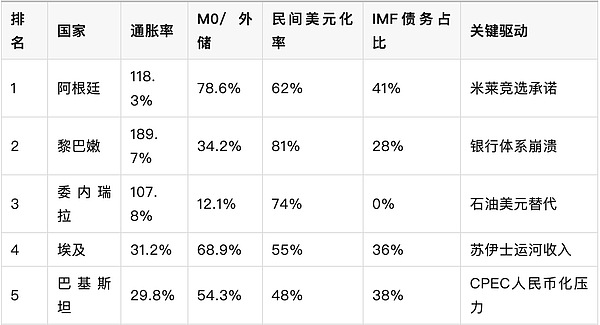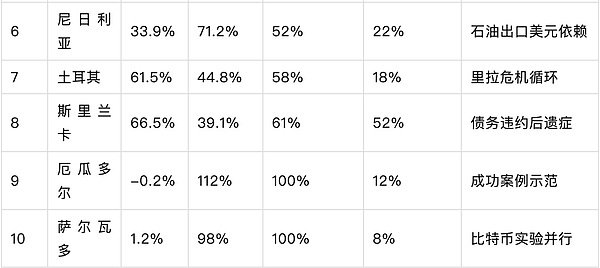The Trump administration is actively exploring ways to encourage other countries to adopt the US dollar as their primary currency in order to counter the trend of de-dollarization. Multiple departments, including the White House Council of Economic Advisers, the National Security Council, the National Economic Council, and the Treasury Department, have held closed-door meetings with Johns Hopkins University professor Steve Hanke to develop a systematic strategy for promoting the dollar. Hanke, a leading authority in global monetization, spearheaded the dollarization processes in Montenegro (1999) and Ecuador (2000) and designed the monetary council systems for five countries: Estonia, Lithuania, Bulgaria, Bosnia, and Argentina (quasi-monetary council). His views are crucial for understanding current policy trends. I. A Realistic Assessment of the Threat of De-dollarization As of November 2025, the US dollar's share of global foreign exchange reserves had fallen to 58.4% (IMF COFER data, Q3 2025), a further decline from the 2021 peak of 59.2%. During the same period, the internationalization of the RMB accelerated, with RMB payments in the SWIFT system rising to 4.12% (October 2025), more than double that of 2020. In intra-BRICS trade, the proportion of non-US dollar settlements reached 36% (Brazilian Central Bank 2025 report), with over 95% of bilateral trade between China and Russia settled in their respective currencies. Russia's foreign exchange reserves in US dollars have plummeted by 78% since 2018, while China continues to increase its gold holdings (its central bank gold reserves will reach 2,312 tons in October 2025, accounting for 12.8% of its foreign exchange reserves) and is promoting energy contracts denominated in RMB with countries along the Belt and Road Initiative. In August 2025, Saudi Arabia settled $50 billion worth of oil exports in RMB for the first time, marking a widening crack in the petrodollar system. The Trump team views this as a national security threat. An internal White House assessment indicates that if the dollar's reserve currency status falls below 50%, the US could save approximately $120 billion annually in seigniorage, equivalent to 0.4% of GDP. More seriously, rising dollar funding costs will amplify the pressure on federal debt – interest payments in fiscal year 2025 have already reached $1.18 trillion (CBO forecast), accounting for 22.3% of federal revenue. II. Three Institutional Paths for Promoting the US Dollar The policy framework submitted by Hankey to the government includes a three-tiered mechanism for the internationalization of the US dollar: 1. Official Dollarization Completely abandoning one's own currency and adopting the US dollar as the legal tender, unit of account, and tax payment instrument. Currently, Ecuador (2000), El Salvador (2001), Zimbabwe (partially in 2009), East Timor, Palau, and the Marshall Islands have adopted it globally. Panama has been officially dollarized since 1904 and has not experienced a banking crisis in the past 120 years. Advantages: Eliminating currency mismatch risk and ending hyperinflation (Ecuador's inflation rate was 96% in 1999, dropped to 4% in 2001, and is projected to be -0.2% in 2025). Attracting foreign investment back to China and ending the cycle of capital flight. Reducing the probability of sovereign default (Panama has had no default record in its century-long history). Implementation Conditions: The central bank only needs to hold sufficient gross foreign exchange reserves to cover the monetary base (M0), not necessarily positive net reserves. As of October 2025, the Central Bank of Argentina had approximately US$28 billion in gross reserves and US$22 billion in M0, theoretically possessing the capacity for conversion. 2. Currency Board (CPC) This board retains its own currency symbol but pegs it to the US dollar at a fixed exchange rate, with 100% of its currency issuance backed by US dollar reserves. The Bulgarian Currency Board, led by Hanki in 1997, pegged the lev to the German mark (later the euro), reducing inflation from 1,081% in 1996 to 1% in 1998. Advantages: Preserving the symbolic representation of monetary sovereignty facilitates political acceptance. Enforcing fiscal discipline prevents the government from over-financing through the central bank. It can serve as a transitional solution for dollarization.
Latest Case: In 2025, the Central Bank of Lebanon is negotiating with the United States to establish a currency committee pegged to the US dollar, intending to replace the collapsing Lebanese pound (the black market exchange rate has reached 1:100,000) with a fixed exchange rate of 1:150,000. 3. Private Stablecoins (GENIUS Act Framework) The GENIUS Act, passed in July 2025, requires issuers of US dollar stablecoins to hold 100% of their reserves in US Treasury securities or cash equivalents and to be subject to Treasury oversight. As of November 2025, the total market capitalization of stablecoins compliant with the GENIUS standard reached $286 billion (Fed data), a 312% increase from 2024. Mechanism: For every stablecoin issued, one US dollar of Treasury bonds must be deposited, forming a "private monetary committee." Fiscal Effect: New Treasury bond demand in fiscal year 2025 is estimated at approximately US$110 billion, lowering the 10-year US Treasury yield by approximately 8 basis points (Morgan Stanley calculations). III. Target Country Screening and Prioritization Hanji conducted an eight-dimensional assessment of over 200 central banks globally (inflation rate, foreign exchange reserve coverage, capital flight index, private use of dollarization, IMF debt ratio, political stability, regional demonstration effect, and Trump's personal relationships), selecting 50 high-potential countries. The top ten are as follows (data in November 2025):


Argentina Priority Analysis:
Capital flight will reach a cumulative total of US$177 billion by 2025 (Hankey-Frank Varro model), accounting for 76% of cumulative debt. If dollarization is achieved, GDP growth is projected to reach 8.3% in the first year (similar to the Ecuadorian effect in 2000), attracting a return of $40-60 billion in capital. Although the Miley government has delayed its plans due to pressure from the IMF, Trump's personal intervention could force the IMF to make concessions (similar to the Ecuadorian case in 2000). IV. Predicting Regional Chain Reactions IV. Predicting Regional Chain Reactions
South American Domino Effect: Argentina's dollarization will trigger a regional demonstration effect.
Bolivia (inflation 42%) has a private dollarization rate of 67%, and the central bank's reserves are only enough to cover 41% of M0.
Peru's Congress (inflation 38%) launched a feasibility study on dollarization in September 2025. Brazil's Central Bank Governor stated in October 2025 that he "does not rule out the option of a monetary committee." Hanki predicts that if Argentina completes dollarization by 2026, 80% of South American countries will achieve official or quasi-dollarization by 2030.
Middle East Energy Anchoring: If Egypt adopts a currency peg to the US dollar, Suez Canal revenue (an average of $9 billion annually) will be fully dollarized, accelerating the de-yuanization of Gulf countries. In November 2025, Kuwait restarted negotiations with the United States to restore the dollar peg, which was abandoned in 1961. V. The Strategic Supporting Role of Stablecoins While not the main focus, the GENIUS Act stablecoin constitutes an important supplement: In Venezuela, USDT's daily trading volume reaches $120 million, accounting for 0.4% of GDP, making it a de facto parallel currency. **Technology Spillover** Circle will launch GENIUS-compliant USDC in 2025, achieving a 28% penetration rate in Nigeria and reducing the Naira black market premium. **Fiscal Dividend** Stablecoin reserves are entirely invested in US Treasury bonds; new demand in 2025 will be equivalent to 15% of the Fed's QE program, effectively offsetting China's reduction of US Treasury holdings (US$180 billion in the first three quarters of 2025).
VI. Gold's Position in the Dollar Hegemony Cycle
On November 6, 2025, the spot price of gold in London was $4,126 per ounce, an increase of 87% compared to the beginning of 2024. Hanki predicted the bull market peak to be $6,000 per ounce based on the "disposable income percentage method," corresponding to 10% of per capita disposable income (the peak level in 1980). Driving Factors: Geopolitical Asset Freeze Cycle: Iran in 1979, Russia in 2022, and a potential new Middle East freeze in 2025. Central Bank Gold Buying Spree: Global central banks' net gold purchases reached a record high of 1,186 tonnes in the first 10 months of 2025 (World Gold Council). US Treasury Credit Premium: The 10-year US Treasury/TIPS spread rose to 2.81%, suggesting that inflation expectations and default risks coexist. Options Market Signals: COMEX gold options expiring November 24, 2025, open interest: Calls above $4,000: 8,514 contracts ($8.514 billion) Puts below $4,000: 4,812 contracts ($4.812 billion) The bullish/bearish ratio is 1.77:1, indicating that institutions are betting on consolidation around the $4,000 level.
VII. Institutional Obstacles and Breakthrough Paths
1. IMF Resistance
The IMF holds structural opposition to dollarization (the cases of Argentina in 2025 and Ecuador in 2000). However, the United States, as the largest shareholder (16.5% voting rights), can exert pressure through its executive board. Trump may emulate Reagan in the 1980s by threatening to reduce US contributions to the IMF (to $32 billion by 2025), forcing it to change its stance. 2. Central Bank Balance Sheet Obstacles Traditional views require positive net reserves, but in reality, only gross reserves need to cover M0. The Lebanese Central Bank's net reserves are projected to be -$42 billion in 2025, but its gross reserves will reach $18 billion, sufficient to support a 1:150,000 peg. 3. Political Transaction Costs Dollarization requires abandoning seigniorage (approximately 1-2% of GDP). Compensation could be provided through the following: A 10-year low-interest loan from the United States (similar to the $600 million bridging loan to Bulgaria in 1997). Opening up agricultural export quotas (Argentine soybeans, beef). A military base agreement (negotiations on the Manta base in Ecuador are underway). VIII. Constitutional Solutions for Government Shutdown and Fiscal Discipline The US federal government faces the risk of its longest shutdown in history in 2025 (CBO predicts it will continue until March 2026 without an agreement). Hankey proposes a constitutional amendment called "The Swiss Debt Brake": Federal spending growth must not exceed the real GDP growth rate. Deficits are limited to cyclical adjustments, with zero structural deficits. The Article V constitutional convention, triggered by 36 states (requiring 34 states, already achieved), bypasses congressional resistance. International Mirror Effect: Dollarized countries, lacking central bank financing channels, automatically achieve fiscal "straight jackets." Ecuador's fiscal deficit in 2025 is only 0.8% of GDP, and its public debt/GDP ratio is 42%, far better than Argentina's (142%).
IX. Conclusion: Structural Reshaping of Dollar Hegemony
The Trump administration's dollar promotion strategy is not a zero-sum game, but rather a win-win situation for all parties through institutional output:
The United States
Consolidating seigniorage, lowering financing costs, and curbing China's financial expansion.
Target countries: End hyperinflation, attract capital repatriation, and break the cycle of defaults. Provide public goods and stabilize emerging market finances. If Argentina breaks through this barrier first in 2026, the South American dollarization wave will reshape the global monetary landscape. By combining the penetration of stablecoins under the GENIUS Act with strategic gold reserves, the United States can stabilize the proportion of dollar reserves at over 55% by 2030, successfully reversing the trend of de-dollarization.
 Weatherly
Weatherly





